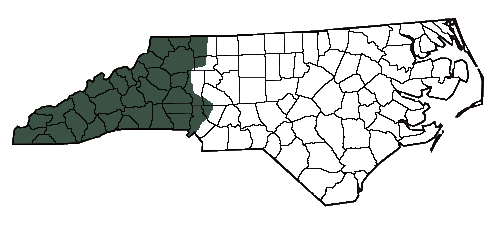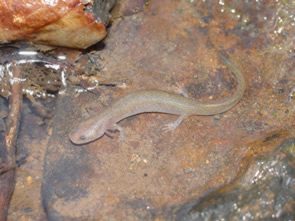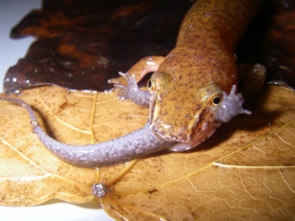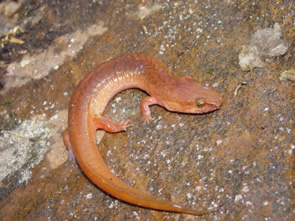
Gyrinophilus porphyriticus
Photo by JD Willson
Description: This large, stout salamander may reach lengths of up to 9 inches. Coloration of the body ranges from pale pink to reddish orange. The back and sides usually contain scattered black spots, with spots or dark mottling on the back occasionally forming a reticulated pattern. Spring salamanders also have a line that extends from each eye to the tip of the snout. Larvae can get very large and typically have a grey or brown base color and blocky heads with squared-off noses.
Habitat/Range: Spring salamanders may be found in and around headwater streams, caves, springs, and seepages. These salamanders reach their highest densities throughout the mountains of North Carolina but may also be found in headwater streams and springs in the western Piedmont. Despite having a wide range in western North Carolina, spring salamanders are known for being difficult to find.
Diet: Although spring salamanders in northern populations feed primarily on invertebrates, spring salamanders in North Carolina are known to consume large numbers of other salamanders. Large spring salamanders will even cannibalize smaller spring salamanders. Although half of an adult’s diet may consist of salamanders, larval spring salamanders feed primarily on invertebrates and consume fewer salamanders.
Reproduction: Female spring salamanders lay their eggs during the summer and eggs hatch in late summer or early spring. Most females probably lay their eggs in underground recesses in streams and seeps. Hatchling salamanders emerge from their eggs with external gills and spend around 4 years as fully-aquatic larvae before transforming into adults. Individuals may not be sexually mature until they are 4-6 years old.
Miscellaneous: Spring salamanders may cause slower growth rates in other salamanders as these smaller salamanders are forced to change their feeding behavior to avoid predation. Spring salamanders also produce noxious skin secretions to repel potential predators.

The shaded region represents the range of the spring salamander in North Carolina.



Photo by Pierson Hill
A spring salamander consuming a northern dusky salamander.
Photo
by SJ Price


Photo by Pierson Hill
Photo by D Dennis
